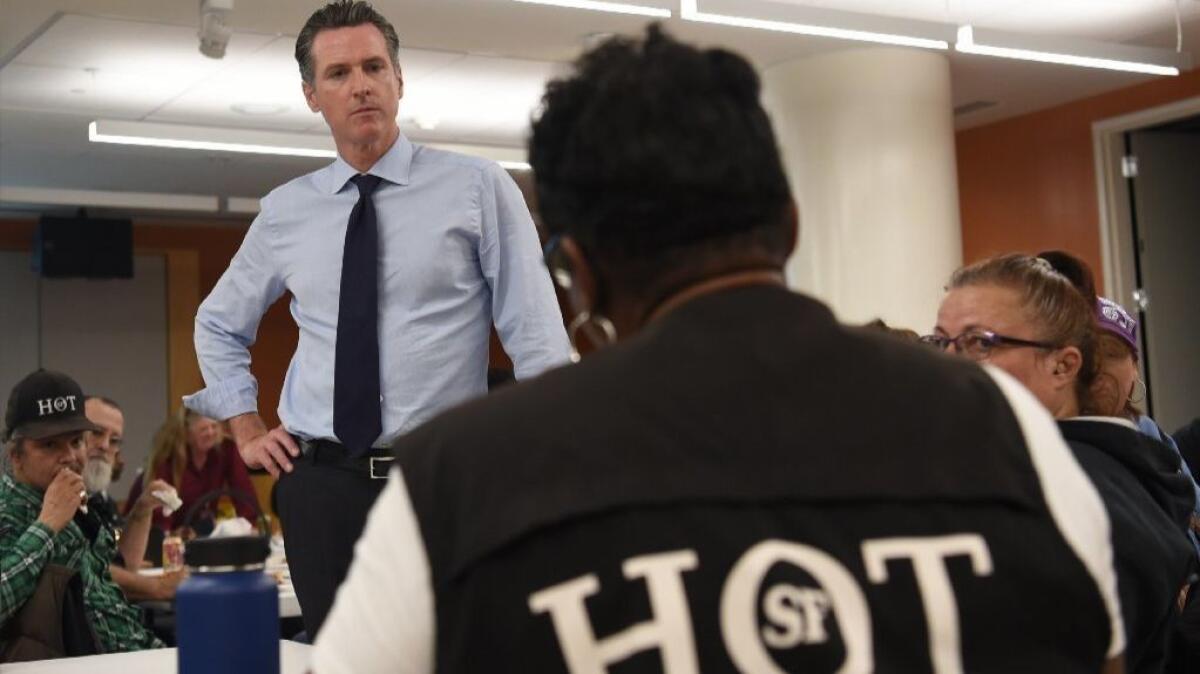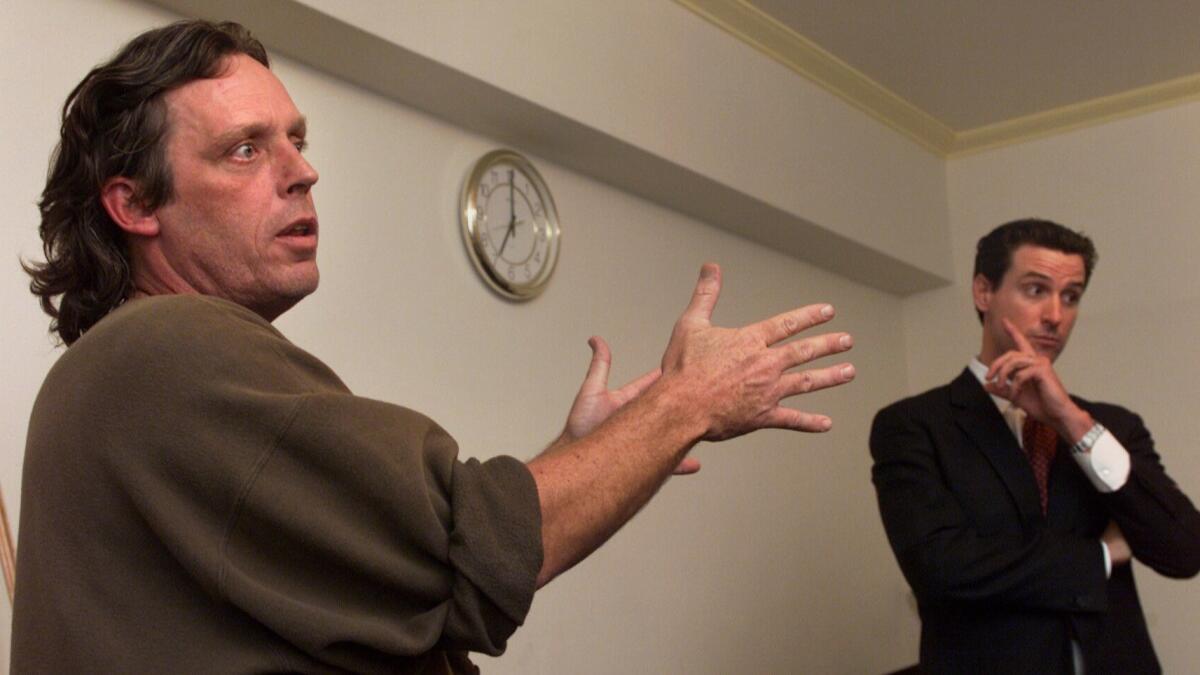Gavin Newsom’s approach to fixing homelessness in San Francisco outraged activists. And he’s proud of it

- Share via
When San Francisco’s homelessness problem swelled in the early 2000s, Gavin Newsom endorsed a radical plan for the famously liberal city.
Then a San Francisco supervisor on the rise, Newsom proposed slashing the amount of welfare for single homeless adults and instead using the funds on shelters, housing and services. Called Care Not Cash, the program sought to stop welfare recipients from spending their monthly checks on heroin or alcohol.
Advocates called it heartless to take money from the homeless. They burned Newsom’s likeness in effigy and spray-painted his garage, forcing him to move, he said. The battle over Care Not Cash ultimately went to the courts and the young politician was branded a hardliner by activists.
“People were outraged,” Newsom wrote in his 2013 book “Citizenville.” “Progressives and Democrats, nuns and priests, homeless advocates and homeless people were furious.”
Now, as the homelessness crisis worsens across the state, how Newsom and other Democratic leaders have handled the issue over the years is the subject of debate ahead of the Nov. 6 election. The state’s homeless population topped 134,000 in 2017, according to the U.S. Department of Housing and Urban Development, a 13.7% jump from the previous year and the largest increase in the nation.
Republican candidate John Cox is ratcheting up his attacks on Newsom over homelessness in the final weeks of the campaign. Cox alleges Newsom failed to fix the problem in San Francisco, and has said his opponent is part of the “political class” whose policies have fueled the rise of encampments, which the Republican labeled “Newsomvilles” in a recent radio spot.
Newsom rejects Cox’s charges, saying his efforts in San Francisco show he’s willing to take politically unpopular positions if he feels it will result in better policy.
He has pledged to put homelessness at the top of his agenda if elected, and has gone so far as to criticize Gov. Jerry Brown, who he said has neglected the issue while in office.
California needs “a governor that is actually focused on these issues, which has not been the case for decades in this state,” Newsom said during a visit this month to a San Diego homeless veterans facility. “Governors have not campaigned on homelessness, governors haven’t talked about homelessness.”
Newsom has said his policies reduced the homeless street population in San Francisco by 40%, an accurate claim for the years 2002 to 2009, according to city statistics. But Newsom was mayor from 2004 to 2011, and the city didn’t perform a count of its homeless population the year he took office, making it difficult to determine the exact number of homeless who left the streets during his tenure.
San Francisco’s homeless count was 7,499 in 2017, compared with 8,640 in 2002, according to the San Francisco Human Services Agency.
Just months after taking office as mayor, Newsom pledged to end chronic homelessness within 10 years — a promise that didn’t pan out. The politician has defended setting the goal, contending that the danger is not in “setting our aim too high and falling short, but in setting our aim too low, and achieving our mark,” a quote borrowed from Italian Renaissance artist Michelangelo, he said.

Under his direction as mayor, thousands of units of supportive housing were built, which his supporters credit with helping San Francisco’s homeless numbers stay flat in recent years in comparison to cities including Los Angeles, which has seen large increases in some annual counts.
But homeless advocacy groups repeatedly clashed with Newsom over policies they said penalized the poor.
Sparking contentious debate, Care Not Cash targeted the city’s 3,000 single homeless adults who received welfare, cutting their payment subsidy from a few hundred dollars to about $60 and putting the money toward low-income housing or shelter beds.
The program was proposed after city officials noticed increases in emergency room visits for overdoses when the welfare checks were issued, said Trent Rhorer, executive director of San Francisco Human Services Agency, who drafted Care Not Cash with Newsom.
In addition, single homeless adults were staying on welfare for an average of four years, longer than other populations on welfare, Rhorer said.
“This cash wasn’t helping this group improve their life at all,” he said.
At the same time, the amount of San Francisco’s welfare check was higher than that in surrounding cities and counties, Rhorer added, leading officials to believe people came to San Francisco for the city’s bigger welfare payment before returning to other areas.
San Francisco business interests backed Care Not Cash, while Democrats broke ranks with Newsom to oppose it. It passed with 60% of the vote in 2002. The victory boosted Newsom’s political standing and he was elected to lead San Francisco the next year.
A 2008 audit by San Francisco’s controller found 2,000 people dropped out of the welfare program after Care Not Cash launched. That confirmed to some officials that people were coming from out of town for the city’s higher check, but critics argued people left the welfare program because they resented that their welfare check was now going toward housing.
Care Not Cash had housed more than 2,100 since it launched in 2004, the audit found. The overall benefit package of housing and services was worth $1,300, according to the audit, far more than the $400 or so that welfare recipients used to receive. In addition, 90% of the tenants remained in supportive housing after one year in the program, Rhorer said.
After Care Not Cash, more people came in to get addiction treatment services at Haight Ashbury Free Medical Clinic, said the facility’s founder, David Smith.
“When Gavin was here, he put public health as one of his top priorities,” Smith said. “That’s why I and the medical community supported him.”
But there were questions about which segment of the homeless population benefited from the program. The San Francisco Chronicle reported in 2004 that the overwhelming number of homeless people moving into supportive housing through Care Not Cash came from shelters and weren’t longtime street residents.
Care Not Cash wasn’t a “broad vision,” said Quintin Mecke, a homeless rights advocate. He said Newsom should have focused instead on new revenue streams for homeless housing. “It was a re-purposing of existing money.”
Paul Boden, the former executive director of San Francisco’s Coalition on Homelessness, said Care Not Cash sent a negative message that people are homeless because they don’t know how to handle money.

“They’re paying for their shelter bed out of their welfare check,” Boden said of the homeless. “That’s not right.”
Homeless advocates also criticized Newsom’s support for a local ballot measure that banned aggressive panhandling in public places and for a program, still in place, that gives homeless people a one-way bus ticket to leave San Francisco and reunite with relatives or friends.
Newsom continues to support laws that prohibit the homeless from sleeping or lying on the sidewalks during certain hours, a divisive issue in cities across the state. A federal court last month ruled that cities can’t criminalize sleeping on public property.
“We’ve allowed these streets to be completely taken over,” Newsom said in an interview earlier this month, adding that “it’s incumbent upon [government] to provide an alternative. It’s not about penalizing, it’s not about criminalizing, it’s about having a tool in the toolkit to encourage someone to move on.”
Criticism over his homeless policies from groups including the Coalition on Homelessness became a “point of pride,” Newsom said.
“The more they opposed, the more I realized that we were about change and not the status quo,” Newsom said.
His proposals for addressing homelessness at the state level include giving tax credits to landlords who rent out units to homeless people, employers who hire the homeless and home builders who construct units geared toward the population.
He wants to bring back a form of the state’s redevelopment program, which allowed local governments to sequester property tax revenue from blighted areas. A portion of that revenue had to be set aside to help build low-income housing. The program was discontinued by Brown over concerns about abuse.
Newsom also wants to create a cabinet position to address homelessness, and to increase services at prisons to prevent inmates from becoming homeless upon release.
California needs a “regional planning approach” to encourage coordination between cites and states, Newsom said. He also said the federal government needs to increase its commitment to creating affordable housing and that homelessness is now a national problem.
“It’s not about the state prescribing a pill to solve this problem,” he said. “We don’t have the money. Flat out, there’s not the resources.”
Homelessness will be “the issue” for Brown’s successor, said state Sen. Holly Mitchell (D-Los Angeles), who has focused on poverty during her time in the Legislature.
“It has spread from the inner city, the urban centers where services have typically been centralized, to truly be a statewide issue,” she said. “So it has to be on the forefront of the next governor’s strategy.”
Cox toured Los Angeles’ skid row last week and said he’d build more housing and help the homeless receive mental health and addiction treatment.
During Cox’s stop, he seemed to align with Newsom’s approach. As he walked by rows of encampments, Cox suggested cash alone wasn’t the answer.
“The people down here need support and help,” Cox told reporters. “They don’t just need money handed out to them, they don’t need just rhetoric. They need actual help.”
Twitter: @dakotacdsmith
More to Read
Get the L.A. Times Politics newsletter
Deeply reported insights into legislation, politics and policy from Sacramento, Washington and beyond. In your inbox three times per week.
You may occasionally receive promotional content from the Los Angeles Times.











